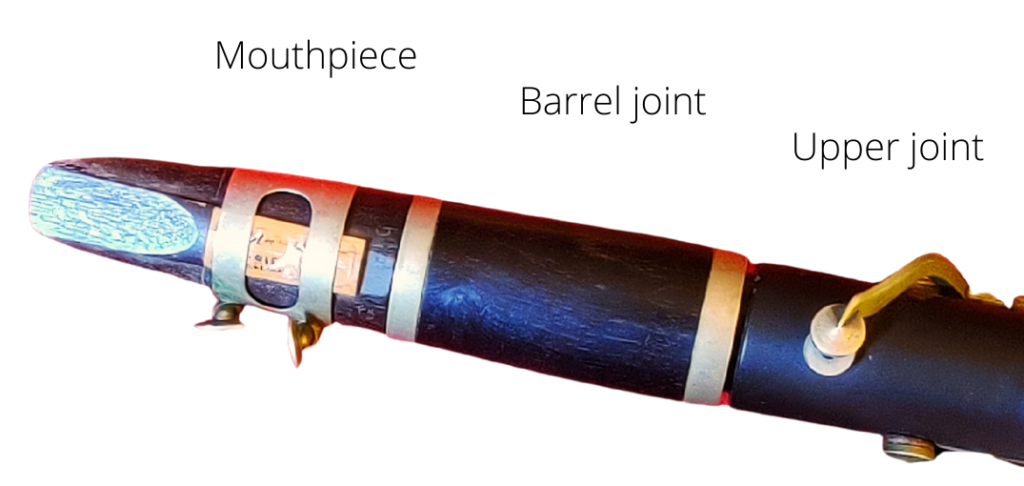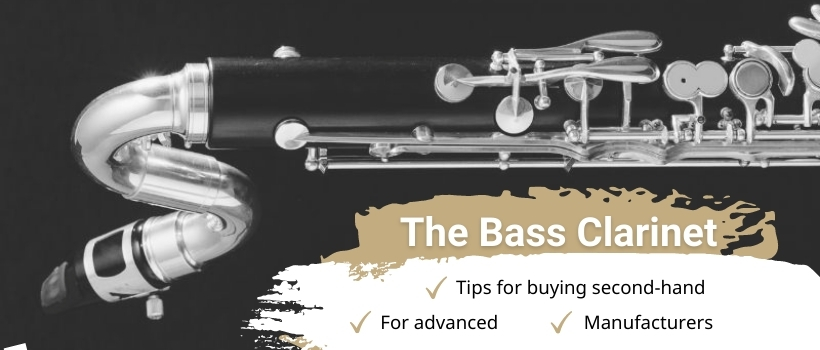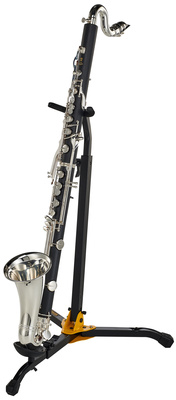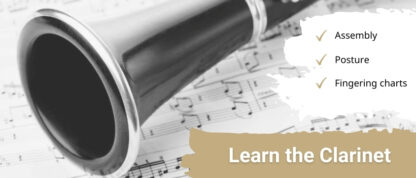The bass clarinet – like every clarinet – belongs to the woodwind instruments. Within the clarinet family, it belongs to the lower-sounding instruments. As it is very large and unwieldy, it is not suitable for beginners and children. Bass clarinets often underline exciting passages in film music or are used in jazz.

What distinguishes the bass clarinet?
The inventor of the saxophone, Aldophe Sax, developed the bass clarinet around 1830, so it is very similar to the saxophone in appearance: instead of the barrel joint, the bass clarinet has a neck and the body is also larger and made of metal. With a length of up to 1.30 metres, the instrument is no longer suitable for balancing on the thumb rest. Instead, a carrying strap is a good choice, or even a spike on which the clarinet can be supported while playing. The sound of the bass clarinet is in the lower range. The bass clarinet is also available in German and Boehm versions. As a transposing instrument, it sounds in low Bb, i.e. a major second and an octave lower.
For whom is the bass clarinet suitable?
Since the bass clarinet is very large and unwieldy, it is not suitable for beginners and children. In order to have fun playing the bass clarinet, one should only dare to play it when one has already gained some experience. The bass clarinet is mainly used as a secondary instrument in the orchestra or in jazz and film music. But the bass clarinet is also becoming increasingly popular as a solo instrument.
What does the bass clarinet sound like?
The bass clarinet has a very wide range: it plays from B1 to a2 (h2). As a transposing instrument, it sounds in low B, i.e. a major second and an octave lower. Only the subcontrabass clarinet plays lower than the bass clarinet. If you prefer to play higher notes, you can look for an E-flat or B-flat clarinet, for example.
In this video you can get an exact picture of the sound of the bass clarinet:
Which equipment is available for the bass clarinet?
The mouthpiece
If you want to individualise your bass clarinet, you can do so with the mouthpiece. Here you should make sure that the mouthpiece fits the respective variant (German or Boehm). The mouthpieces differ in material, length and opening.
All these factors also affect the sound. To find out which mouthpiece suits you and your clarinet best, try different ones to get a feeling for your preferred sound.
The Reed
The reed must be replaced regularly, as it becomes soft over time and can tear. You can adjust the sound of your bass clarinet to suit you by choosing the right reed. The reeds differ mainly in strength: the stronger the reed, the more power it takes to produce a sound with it. As a beginner, you should start with a soft reed and work your way up slowly.
The reeds also differ in cut. Here it is important that the reeds are compatible with the construction of the mouthpiece. A German mouthpiece therefore also needs a corresponding reed cut.
The Barrel Joint
The connecting piece between the mouthpiece and the top piece is called the barrel joint. It can also have an effect on the sound of your clarinet. Here, too, the compatibility with the German or Boehm construction is important. In addition, length, bore, shape and material have an effect on the sound characteristics. Here, too, the only way to find the ideal barrel joint for your own style is to try it out.

Before buying a barrel joint, you should also seek advice on potential problems. For example, barrels made from mixed species are beautiful to look at but have a higher risk of cracking due to the different expansion rates of the species.
Cleaning the clarinet
If the condensation from the breathing air collects in the clarinet over a long period of time, it can be damaged. It is therefore important to clean the instrument after each playing session. To do this, carefully dismantle the clarinet into its individual parts. Carefully wipe the reed dry and store it safely.
The remaining parts are wiped with a cotton cloth so that there is no more moisture inside. If necessary, oil the flaps and grease the corks at the joints.
Everything you need to clean your clarinet can be found in special cleaning sets for clarinets. They contain cotton cloths with weights for easier cleaning, pipe cleaners and the appropriate care oils.
Which manufacturers are there for bass clarinets?
The manufacturers of bass clarinets are as varied as their prices. Well-known manufacturers are, for example, Thomann, Yamaha or Buffet Crampon.
The entry-level model
This model from Thomann is made of plastic and equipped with a silver-plated mechanism. This bass clarinet is built according to the Boehm fingering. It comes with a mouthpiece, reed screw, a wiper and other care accessories.
High quality with Boehm fingering
Made of grenadilla wood and with a silver-plated mechanism, cup and bow, ist this bass clarinet from Buffet Crampon. The light and compact body makes it easy to handle, and the adjustable thumb rest also ensures a high level of comfort when playing.
Professional model with German fingering
This bass clarinet in German fingering is made of grenadilla wood. The neck, the cup and the keys are silver-plated. The adjustable thumb holder with ring for attaching a carrying cord ensure the best possible comfort when playing. The mouthpiece and a case for safe storage are included.
FAQ: The Bass Clarinet
The bass clarinet has a very wide range: it plays from B1 to a2 (b2).
As a transposing instrument, the bass clarinet sounds in low Bb, i.e. a major second and an octave lower. Only the subcontrabass clarinet plays lower than the bass clarinet. If you prefer to play higher notes, you can look for an alto clarinet or E-flat clarinet, for example.
The bass clarinet is up to 1.30m long. To play it, therefore, it needs a riser or a spike on which the clarinet can be placed. It is rather unsuitable for beginners and children because of its size.













